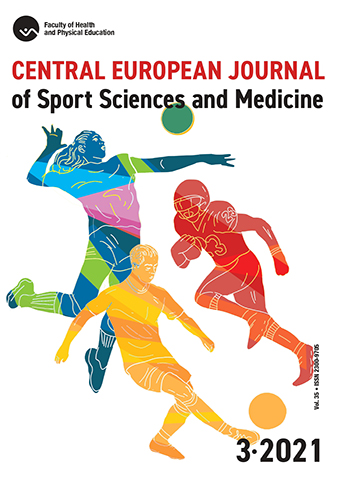
ISSN: 2300-9705
eISSN: 2353-2807
OAI
DOI: 10.18276/cej.2021.3-10




Issue archive /
Vol. 35, No. 3/2021
Surgical Mask Use in Physical Ecercise in Young Healthy Subjects Sume Trial
| Authors: |
Hugo
Mendonça Café

Hospital Particular do Algarve, Gambelas, Portugal Marta Leitão 
Hospital Particular do Algarve, Gambelas, Portugal Anya Freitas 
Faro Health Center, Portugal Ana Marreiros 
Medicine and Biomedical Sciences Faculty, University of Algarve, Portugal |
| Keywords: | surgical mask exercise treadmill test stress test oxygen saturation Covid19 EC |
| Data publikacji całości: | 2021 |
| Page range: | 9 (117-125) |
Abstract
In the context of the COVID-19 pandemic, the use of surgical masks has become the new normal. The use of these devices in exercise and medical situations has been advocated with the purpose of reducing contagions, but some concerns exist regarding its impact of physical fitness and safety of use. If the use of mask while exercising can cause decreased functional capacity or dangerous hypoxemia is still something we know little of. Therefore, we performed maximal treadmill stress tests in 12 healthy young subjects, with and without surgical mask use, and measured exercise capacity, oxygen saturation (rest, peak exercise and post-exercise) and electrocardiographic changes on a standard treadmill test. Exercise capacity and oxygen saturation levels decreased in peak exercise vs rest in a statistically significant manner when mask was used. ECG changes, although not significant, were present in 3 subjects when mask was used and disappeared when the test was made unmasked. We concluded that masked exercise has the potential to cause decreased exercise load and oxygen saturation and potentially cause diagnostic errors in medical exams.
Download file
Article file
Bibliography
| 1. | Basset, F.A., Boulay, M.R. (2000). Specificity of treadmill and cycle ergometer tests in triathletes, runners and cyclists. Eur J Appl Physiol, 81 (3), 214–21. DOI: 10.1007/s004210050033. |
| 2. | Bruce, R.A., Blackmon, J.R., Jones, J.W., Strait, G. (1963). Exercise testing in adult normal subjects and cardiac patients. Pediatrics, 32, 742–756. |
| 3. | CDC (2020). Recommendation regarding the use of cloth face coverings, especially in areas of significant community-based transmission. |
| 4. | Chandrasekaran, B., Fernandes, S. (2020). “Exercise with Facemask; Are We Handling a devil’s sword?” – A Physiological Hypothesis. Med. Hypothesis, 144, 110002. DOI: 10.1016/j.mehy.2020.110002. |
| 5. | Coustet, B., Lhuissier, F.J., Vincent, R., Richalet, J.P. (2015). Electrocardiographic changes during exercise in acute hypoxia and susceptibility to severe high-altitude illnesses. Circulation, 131 (9), 786–794. DOI: 10.1161/CIRCULATIONAHA.114.013144. |
| 6. | ECDC (2020). Using face masks in the community – reducing COVID-19 transmission from potentially asymptomatic or presymptomatic people through the use of face masks. |
| 7. | Entwistle, M.D., Sommerville, D., Tandon, A.P., Jones, J.G. (1994). Effect of hypoxaemia on the resting electrocardiogram (ECG) in patients with cardiac ischaemia. Ann Acad Med Singap, 23 (4), 460–464. |
| 8. | Fikenzer, S., Uhe, T., Lavall, D. Rudolph, U., Falz, R., Busse, M., Hepp, P., Laufs, U. (2020). Effects of surgical and FFP2/N95 face masks on cardiopulmonary exercise capacity. Clin Res Cardiol, 109 (12): 1522–1530. DOI: 10.1007/s00392-020-01704-y. |
| 9. | Fletcher, G.F., Ades, P.A., Kligfield, P., Arena, R., Balady, G.J., Bittner, V.A., Coke, L.A., Fleg, J.L., Forman, D.E., Gerber, T.C., Gulati, M., Madan, K., Rhodes, J., Thompson, P.D., Williams, M.A. (2013). American Heart Association Exercise, Cardiac Rehabilitation, and Prevention Committee of the Council on Clinical Cardiology, Council on Nutrition, Physical Activity and Metabolism, Council on Cardiovascular and Stroke Nursing, and Council on Epidemiology and Prevention. Exercise standards for testing and training: a scientific statement from the American Heart Association. Circulation, 128 (8), 873–934. DOI: 10.1161/CIR.0b013e31829b5b44. |
| 10. | Garner, K.K, Pomeroy, W., Arnold, J.J. (2017). Exercise Stress Testing: Indications and Common Questions. Am Fam Physician, 96 (5), 293–299. |
| 11. | Gibbons, R.J., Balady, G.J., Beasley, J.W., Bricker, J.T., Duvernoy, W.F., Froelicher, V.F., Mark, D.B., Marwick, T.H., McCallister, B.D., Thompson, P.D., Winters, W.L. Jr., Yanowitz, F.G., Ritchie, J.L., Cheitlin, M.D., Eagle, K.A., Gardner, T.J., Garson, A.Jr, Lewis, R.P., O’Rourke, R.A., Ryan, T.J. (1997). ACC/AHA guidelines for exercise testing: executive summary. A report of the American College of Cardiology/American Heart Association Task Force on Practice Guidelines (Committee on Exercise Testing). Circulation, 96 (1), 345–54. |
| 12. | Greenhalgh, T. (2020). Face coverings for the public: Laying straw men to rest. J Eval Clin Pract., 26: 1070–1077. DOI: 10.1111/jep.13415. |
| 13. | Hsia, D., Casaburi, R., Pradhan, A., Torres ,E., Porszasz, J. (2009). Physiological responses to linear treadmill and cycle ergometer exercise in COPD. Eur Respir J, 34 (3), 605–615. |
| 14. | Kisan, R., Kisan, S.R., Or, A., Sp, C. (2012). Treadmill and Bicycle Ergometer Exercise: Cardiovascular Response comparison. The Journal of medical research, 12 (5). |
| 15. | Roger, V.L., Jacobsen, S.J., Pellikka, P.A., Miller, T.D., Bailey, K.R., Gersh, B.J. (1998). Prognostic value of treadmill exercise testing: a population-based study in Olmsted County, Minnesota. Circulation, 98 (25), 2836–2841. DOI: 10.1161/01.cir.98.25.2836. |
| 16. | Shaw, K., Butcher, S., Ko, J., Zello, G.A., Chilibeck, P.D. (2020). Wearing of Cloth or Disposable Surgical Face Masks has no Effect on Vigorous Exercise Performance in Healthy Individuals. Int J Environ Res Public Health, 17 (21), 8110. DOI: 10.3390/ijerph17218110. |
| 17. | Tabata, I., Irisawa, K., Kouzaki, M., Nishimura, K., Ogita, F., Miyachi, M. (1997). Metabolic profile of high intensity intermittent exercises. Med Sci Sports Exerc, 29 (3), 390–395. DOI: 10.1097/00005768-199703000-00015. |